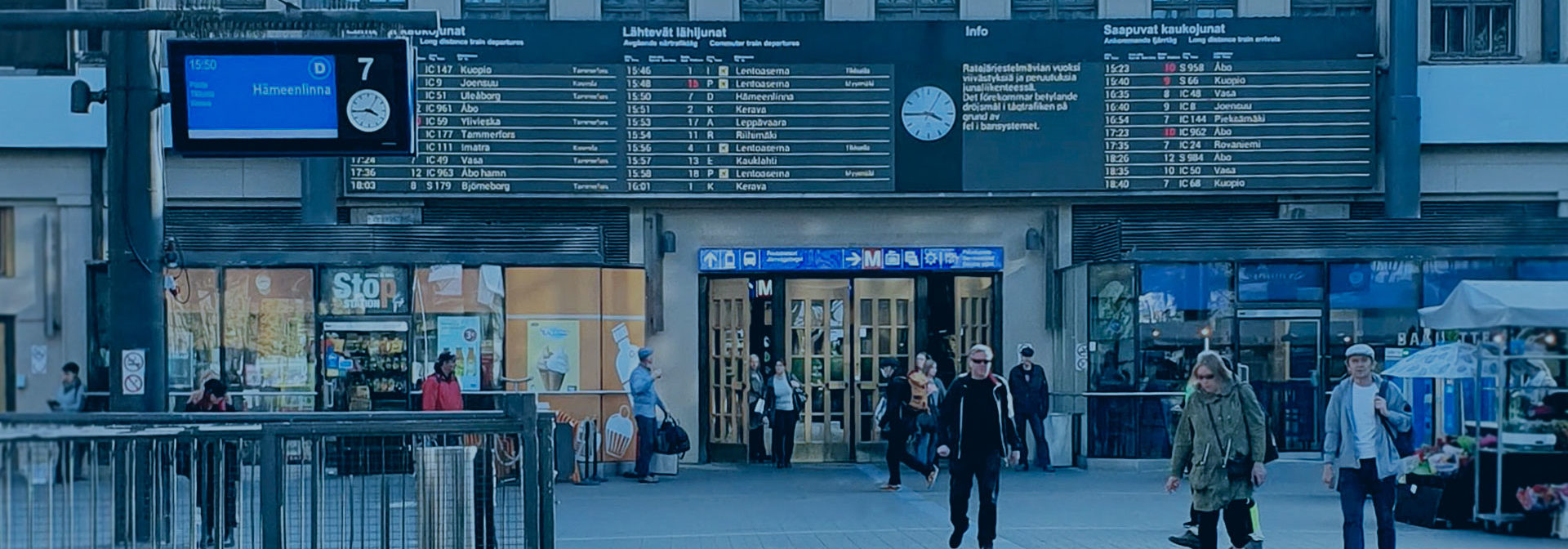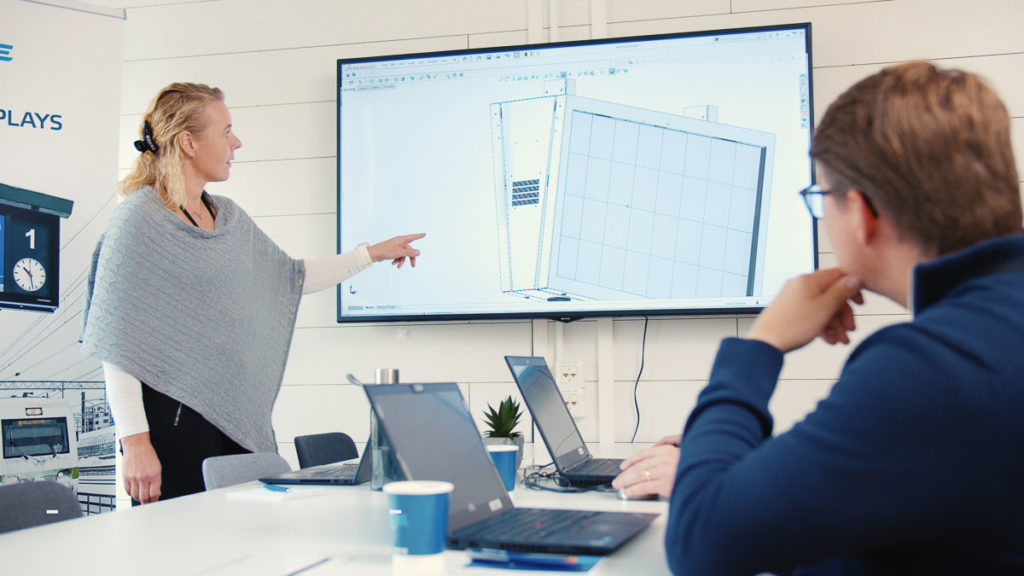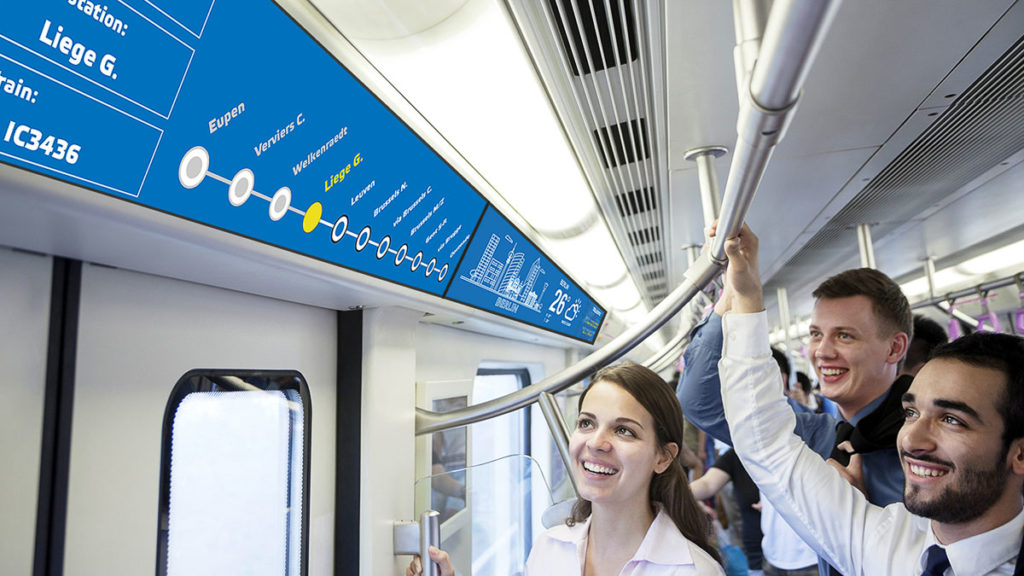
Information displays have a bright future ahead
Passengers and consumers in general are much savvier when it comes to knowing what they want from their visual display experiences. Smartphones and modern high resolution consumer displays have raised the bar for what is expected from information displays. End users are now accustomed to high brightness, great contrast, and smooth video playback, which not only requires more from the displays and panels but also from the hardware that is driving them.
Increased environmental requirements are also driving change in our industry, which has raised the need and focus on lower energy consumption and longer lifetime for displays and related hardware. At Teleste, these factors are considered from the moment our in-house team gets the design plans from our customers, and our built-in diagnostics tools ensure that the requirements are met long after the products are delivered and installed.

From monochrome to living color
Among the biggest display technology advancements in the industry is the transition from Monochrome LED technology to RGB LED. The latest RGB small pixel pitch HD LED displays provide significantly sharper detail, vivid color reproduction and excellent readability at all viewing angles. The new technology also makes it possible to bump up the peak brightness to 6000 candelas (cd/m2) making it possible for RGB LED displays to be viewed in direct sunlight without issues. In addition, Teleste’s RGB LED solutions offer automatic brightness control that adjusts the brightness according to ambient light conditions.
Lifetime requirements are one of the key drivers of the future and RGB LED technology is also excellent in this regard. It offers an excellent lifespan with up to 100,000 hours of use and it is able to retain high brightness levels throughout its lifespan. Teleste’s RGB LED solutions are driven by extremely durable industrial grade PCs, making sure that the hardware driving the screens is equally as durable as the screens themselves, and this goes for all our display solutions. RGB LED technology is designed specifically for outdoor display applications, including main, platform, concourse and timetable displays. It is also extremely durable, and it is able to perform at any climatic conditions. The IP65-certified housing ensures that dust, rain and snow are never a concern.
Tried and tested TFT LCD technology remains as a viable option
For displaying more complex visual content, including moving graphics and video, Teleste offers a wide array of TFT LCD display solutions for different environments. Our outdoor TFT LCD display solutions are also designed and certified for the most challenging conditions and they provide an outstanding visual experience for graphics and moving content. Among the most interesting developments in TFT technology is that panels are now available in different shapes and sizes from squares and super ultra-wides to circular screens, which makes it possible to rethink how and where displays can be utilized. They allow for more creative freedom when designing new rail car interiors, but also provide flexibility for when retrofitting ones.
Ultrawide displays are now being used to replace train & route map stickers on trains, trams, and metro cars, after which they can offer much more relevant real time information to passengers. Viewing angles in these use cases are of course especially important, as route maps need to be able to be viewed from often obscure angles. PLS and IPS panels offer vastly improved viewing angles compared to displays equipped with for example TN-based LCD-panels, so it is important to choose panel types based on specific viewing needs.
Increased environmental requirements are also driving change in our industry, which has raised the need and focus on lower energy consumption and longer lifetime for displays and related hardware.
TFT LCD technology is a tried and tested technology that is still a very viable option for many scenarios. No matter the shape or size requirements, our in-house design team can customize the screens and housing to all specifications and validation standards. Requirements, naturally, vary depending on location. Small indoor displays cannot be used outdoors or at stations. Each has their own validation standards and requirements based on different use-case scenarios. Brightness requirements for outdoor displays are immensely higher than for those of indoor displays and modern outdoor displays are also required to endure all environmental conditions, including blizzards that surprised much of southern Europe at the beginning of 2021. With the climate in flux, it is essential to prepare for the worst-case-scenarios. Safety and electromagnetic compatibility requirements are also particularly important in the transportation industry, and our displays are validated against all the required standards case by case as per our customer’s needs.

Intelligent features to maintain high performance and long life span
Our high-quality displays are designed for 24/7 use in outdoor, indoor, and on-board. However, maintaining a high level of performance throughout the display’s lifespan requires more than just display itself. One of our highlight technologies is our new display diagnostic card that can be installed in all our POP displays. The diagnostic card provides a new layer of intelligence to existing display technologies. It works as a self-diagnostic tool and safeguard that ensures the stability and long lifespan of the displays with features such as automatic brightness control and preventive maintenance prediction. As an example, the diagnostic card can sense if the display is running too hot in the sunlight, and it can dynamically lower the brightness and power usage of the display among taking other preventive measures. The diagnostic card is a tool that helps our customers maintain their displays and predict maintenance costs in the long term, ensuring a long lifespan.
Always looking to the future
We are constantly keeping tabs on emerging display technologies to be able to offer the best solutions to our customers. MiniLed and MicroLED technologies in particular are looking like promising candidates to replace traditional LCD technology in the future. MicroLED is a self-emissive display technology that offers super high brightness and contrast with unmatched modularity and lifespan. MicroLED is debuting on the consumer market this year, and mass scale production can be expected in a handful of years from now, after which the technology will eventually become available to the railway industry as well.
We are constantly keeping tabs on emerging display technologies to be able to offer the best solutions to our customers.
Teleste stays ahead of the curve with the continuous development of our product families as well as new product platforms. We are engaged with development projects to improve competitiveness, modularity, and increased requirements. Much of our recent development efforts have focused on wireless systems in the RSM business as well RGB LED outdoor display technology and we expect this trend to continue. We are also continuously investigating technologies and fast implementation to respond to market needs. This is made possible by high investments into our in-house engineering and our strategy for offering our customers flexibility in our modular designs. Display technology is constantly evolving, but our commitment to strive to succeed together with our customers remains constant.
Piia Sulonen
Piia Sulonen
I’m heading the development of public transport innovations and technologies at Teleste. See my LinkedIn for more information.



